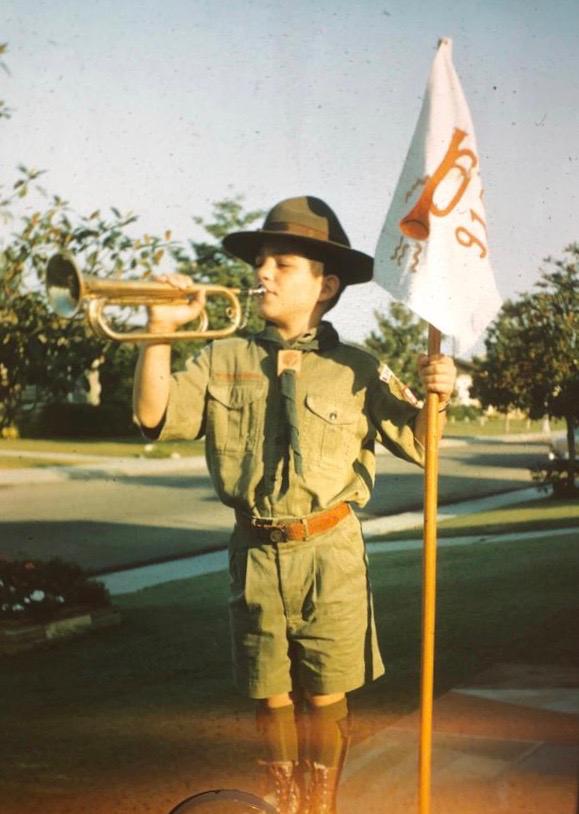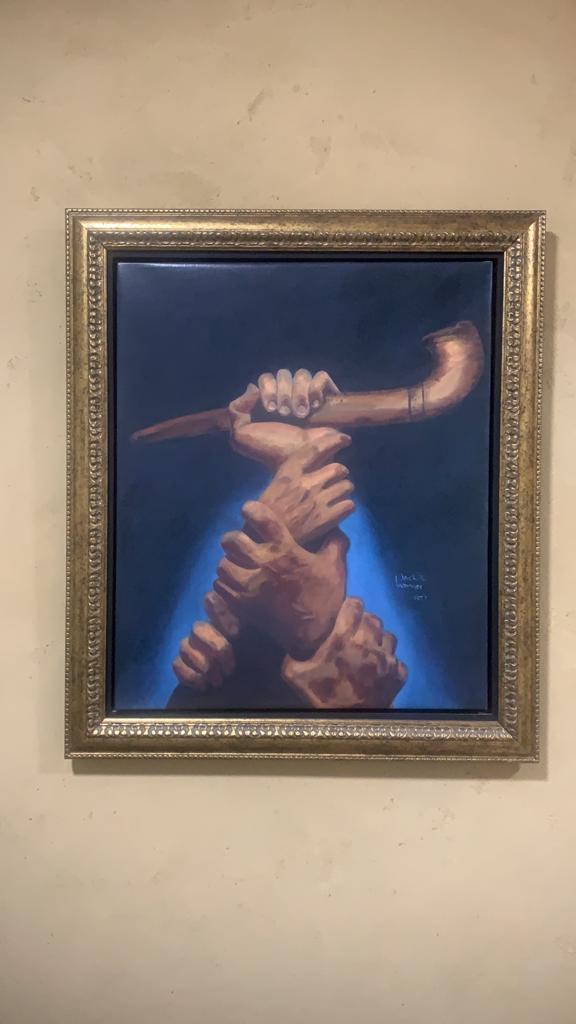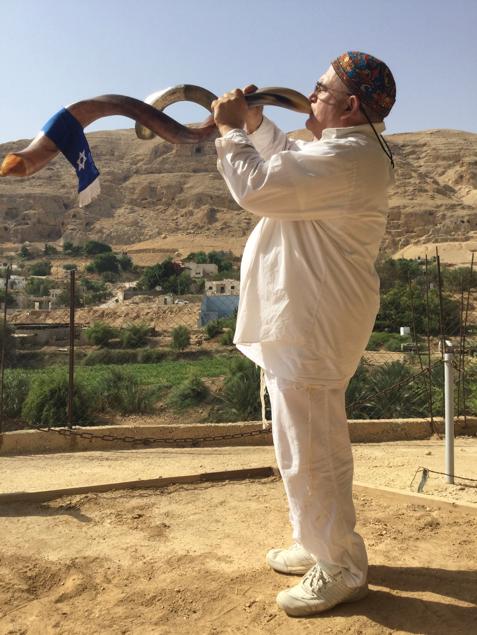
JERUSALEM (JNS) – As first-chair trumpet in the Orville Wright Junior High School band in Los Angeles in 1966, Robbie Weinger didn’t know it, but he was training his lips for their destiny: to enable their owner to become one of the world’s master shofar blowers.
Weinger (who now goes by Robert) and other shofar-blowers have never been more sought-after as they are this year during the global coronavirus pandemic with so many synagogues either closed for business or accepting limited or outside seating for the High Holidays.
That’s why when Jews the world over are looking for someone to blow shofar for them, Weinger plans to be in Jerusalem, part of a team of shofar-sounders dividing up the city by neighborhood so that citizens can fulfill the commandment to hear the shofar blown on the Jewish New Year. Rosh Hashanah begins after sundown on Sept. 18 and continues until sundown on Sept. 20.
Weinger’s life has taken something of a leap. As a kid, he was not only a trumpeter but also a self-described “Hebrew-school rebel” who grew up to be a business executive and “a secular Jew to the core.”
And now? Not only is he known in Israel and beyond as “shofar man,” Weinger is one of the world’s tops blowers—a true baal tekiah (click here to hear him blow two shofars in perfect harmony) who’s running a shofar center in the middle of the Judean Desert.
Weinger will tell you it all began with his personal “burning bush” encounter in 2003 on Mount Diablo (Devil Mountain) outside of San Francisco. He was 52. “That day, I felt for the first time that there was a supernal force managing my life,” he says. “It brought me to my knees, and I wept like a baby.”
Another awakening came in 2008, when he fell deeply in love with the ancient instrument. The ram’s horn was first referenced in the Torah when God used it some 3,700 years ago to call the Israelites together to hear the Ten Commandments at the foot of Mount Sinai.
By 2008, Weinger was in the shofar business full-time. By 2017, he had made aliyah.
Throughout this journey, the man will tell you that he was inspired by his father. After all, Jack Weinger was born just before Rosh Hashanah in 1917 and died exactly 100 years later on Rosh Hashanah 2017. His painting, “The Great Shofar,” is now the insignia of the shop his son runs 7,567 miles from his California birthplace.
It didn’t take that son long to establish Shofar So Great in Beit Hogla, a tiny sand-blown speck on the map in the shadow of the ancient town of Jericho. It was here that the Israelites entered the land and, the priests blew the shofars and the people shouted, collapsing the city’s walls.

The shop is stocked with hundreds of shofars in every size and shape, fashioned from the horns of kudu, gemsbok, goat, and, of course, the traditional ram, many of them illustrated by Israeli artists. Visitors—be they families or groups—also get to hear Weinger share the history of the shofar or take workshops on the fine art of shofar blowing in the visitor’s center.
“Robert also tells the story of his spiritual search and how it landed him in this small eclectic community—what he’s doing here is attracting people to this somewhat hidden part of Israel,” says tour guide Shalom Pollack who often brings groups here. “The people here are pioneers taking a dusty piece of land and making the desert bloom like our ancestors did thousands of years ago.”
Of course, the pandemic has cooled off many, though not all, of the tours, and most of Weinger’s sales are conducted online these days. He also reports a decided uptick since the Jewish world woke up to the fact that opportunities to hear shofar in synagogues will be limited, and they might need to blow shofar themselves for their family, friends and neighbors this year.
‘A prophetic instrument’
On the Jewish New Year, Jews not only pray to be inscribed in the proverbial “Book of Life” for a happy and (this year in particular), healthy new year, but also coronate God as king all over again and resolve to make a fresh start in the new year.
And the shofar is an integral part of all that.
As the sound pierces the listener to the core, it’s a cry of repentance on the day of judgment, hearkening back to the shofar used to call the Israelites to battle. Or, as Rabbi Yehuda Lave of Jerusalem puts it, “It’s also no coincidence that it’s on Rosh Hashanah that we read about the near-sacrifice of Isaac and the ram that was sacrificed in his place.”

“The shofar is a prophetic instrument—hearing it awakens the power of Jewish history in every heart,” says Weinger. “It’s as if God speaks through it directly to His people and everyone who hears this sound—young and old, observant and secular—has an intense spiritual experience, of crying to God for mercy as opposed to judgment.”
“I’ve never heard anyone blow the shofar like Robert,” says Rabbi Hagi Ben Artzi who teaches at Bar-Ilan University in Ramat Gan, as well as a woman’s seminary in Beit Hogla, where he first heard Weinger blow. “You can feel his shofar expressing something very deep, as if the sound comes from the bottom of his heart and spirit.”
In fact, Weinger has developed his own uses for the instrument. Five or six times a day, he hears from people around the world asking him to pray for them or a loved one in trouble. So he sounds the shofar, “petitioning God on their behalf, and God answers.”
“That’s why he’s living so close to Jericho, where the miraculous collapse of these walls occurred through the voice of the shofar,” adds Rabbi Ben Artzi, who has the distinction of being Sara Netanyahu’s brother (and the prime minister’s brother-in-law). “Seeing the prophecy of God gathering His people back to their homeland being fulfilled, every time Robert blows, he’s saying, ‘Listen, God is here.’ ”
‘Every neighborhood needs someone’
Smack dab in the season of COVID-19, High Holidays 2020 (5781) are shaping up to be challenging as Jews the world over scramble to plan for these all-important days.
Rosh Hashanah, the holiday rivaled only by Passover on the family-friendly scale, is expected to find families restricted from gathering. And since, along with Yom Kippur 10 days later, it is historically the No. 1 attendance magnet for synagogues, congregations everywhere are struggling to balance religious traditions and Torah-based mitzvot with government-mandated safety regulations.
Meaning that on Rosh Hashanah, when the primary mitzvah is to hear the shofar, limited seating is likely to pass many shofar honors to smaller neighborhood minyans.
“Every neighborhood needs a shofar and someone who can blow the notes,” insists Weinger, who recommends contacting a local synagogue or Chabad House for a shofar sounding. For those who want to learn to sound the shofar for themselves, Chabad is offering a free course here.

As reported by Vos Iz Neias
